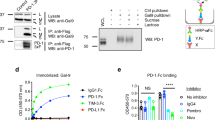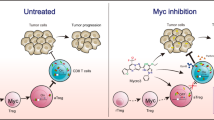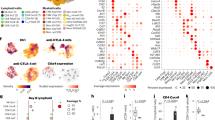Abstract
Immune dysfunction is well documented during tumor progression and likely contributes to tumor immune evasion. CD8+ cytotoxic T lymphocytes (CTLs) are involved in antigen-specific tumor destruction and CD4+ T cells are essential for helping this CD8+ T cell-dependent tumor eradication. Tumors often target and inhibit T-cell function to escape from immune surveillance. This dysfunction includes loss of effector and memory T cells, bias towards type 2 cytokines and expansion of T regulatory (Treg) cells. Curcumin has previously been shown to have antitumor activity and some research has addressed the immunoprotective potential of this plant-derived polyphenol in tumor-bearing hosts. Here we examined the role of curcumin in the prevention of tumor-induced dysfunction of T cell-based immune responses. We observed severe loss of both effector and memory T-cell populations, downregulation of type 1 and upregulation of type 2 immune responses and decreased proliferation of effector T cells in the presence of tumors. Curcumin, in turn, prevented this loss of T cells, expanded central memory T cell (TCM)/effector memory T cell (TEM) populations, reversed the type 2 immune bias and attenuated the tumor-induced inhibition of T-cell proliferation in tumor-bearing hosts. Further investigation revealed that tumor burden upregulated Treg cell populations and stimulated the production of the immunosuppressive cytokines transforming growth factor (TGF)-β and IL-10 in these cells. Curcumin, however, inhibited the suppressive activity of Treg cells by downregulating the production of TGF-β and IL-10 in these cells. More importantly, curcumin treatment enhanced the ability of effector T cells to kill cancer cells. Overall, our observations suggest that the unique properties of curcumin may be exploited for successful attenuation of tumor-induced suppression of cell-mediated immune responses.
This is a preview of subscription content, access via your institution
Access options
Subscribe to this journal
Receive 12 digital issues and online access to articles
$119.00 per year
only $9.92 per issue
Buy this article
- Purchase on Springer Link
- Instant access to full article PDF
Prices may be subject to local taxes which are calculated during checkout







Similar content being viewed by others
References
Ohm JE, Carbone DP . Immune dysfunction in cancer patients. Oncology 2002; 16: 11–18.
Kandil A, Bazarbashi S, Mourad WA . The correlation of Epstein–Barr virus expression and lymphocyte subsets with the clinical presentation of nodular sclerosing Hodgkin disease. Cancer 2001; 91: 1957–1963.
Alexander JP, Kudoh S, Melsop KA, Hamilton TA, Edinger MG, Tubbs RP et al. T cells infiltrating renal cell carcinoma display a poor proliferative response even though they can produce interleukin 2 and express interleukin 2 receptors. Cancer Res 1993; 53: 1380–1387.
Shanker A, Singh SM, Sodhi A . Ascitic growth of a spontaneous transplantable T cell lymphoma induces thymic involution. 1. Alterations in the CD4/CD8 distribution in thymocytes. Tumour Biol 2000; 21: 288–298.
Das T, Sa G, Paszkiewicz-Kozik E, Hilston C, Molto L, Rayman P et al. Renal cell carcinoma tumors induce T cell apoptosis through receptor-dependent and receptor-independent pathways. J Immunol 2008; 180: 4687–4696.
Gastman BR, Johnson DE, Whiteside TL, Rabinowich H . Tumor-induced apoptosis of T lymphocytes: elucidation of intracellular apoptotic events. Blood 2000; 95: 2015–2023.
Sa G, Das T, Moon C, Hilston CM, Rayman PA, Rini BI et al. GD3, an overexpressed tumor-derived ganglioside, mediates the apoptosis of activated but not resting T cells. Cancer Res 2009; 69: 3095–3104.
Das T, Sa G, Hilston C, Kudo D, Rayman P, Biswas K et al. GM1 and TNFα, overexpressed in renal cell carcinoma, synergize to induce T cell apoptosis. Cancer Res 2008; 68: 2014–2023.
Wang Q, Redovan C, Tubbs R, Olencki T, Klein E, Kudoh S et al. Selective cytokine gene expression in renal cell carcinoma tumor cells and tumor-infiltrating lymphocytes. Int J Cancer 1995; 61: 780–785.
Woo EY, Chu CS, Goletz TJ, Schlienger K, Yeh H, Coukos G et al. Regulatory CD4+CD25+ T cells in tumors from patients with early-stage non-small cell lung cancer and late-stage ovarian cancer. Cancer Res 2001; 61: 4766–4772.
Cao Q, Wang L, Du F, Sheng H, Zhang Y, Wu J et al. Downregulation of CD4+CD25+ regulatory T cells may underlie enhanced Th1 immunity caused by immunization with activated autologous T cells. Cell Res 2007; 17: 627–637.
Parmiani G, Rivoltini L, Andreola G, Carrabba M . Cytokines in cancer therapy. Immunol Lett 2000; 74: 41–44.
Shankaran V, Ikeda H, Bruce AT, White JM, Swanson PE, Old LJ et al. IFNγ and lymphocytes prevent primary tumour development and shape tumour immunogenicity. Nature 2001; 410: 1107–1111.
Kemp RA, Ronchese F . Tumor-specific Tc1, but not Tc2, cells deliver protective antitumor immunity. J Immunol 2001; 167: 6497–6502.
Toes RE, Ossendorp F, Offringa R, Melief CJ . CD4 T cells and their role in antitumor immune responses. J Exp Med 1999; 189: 753–756.
Tatsumi T, Herrem CJ, Olson WC, Finke JH, Bukowski RM, Kinch MS et al. Disease stage variation in CD4+ and CD8+ T-cell reactivity to the receptor tyrosine kinase EphA2 in patients with renal cell carcinoma. Cancer Res 2003; 63: 4481–4489.
Khong HT, Restifo NP . Natural selection of tumor variants in the generation of “tumor escape” phenotypes. Nat Immunol 2002; 3: 999–1005.
Marincola FM, Jaffee EM, Hicklin DJ, Ferrone S . Escape of human solid tumors from T-cell recognition: molecular mechanisms and functional significance. Adv Immunol 2000; 74: 181–273.
Sakaguchi S, Sakaguchi N, Asano M, Itoh M . Toda M . Immunologic self-tolerance maintained by activated T cells expressing IL-2 receptor alpha-chains (CD25). Breakdown of a single mechanism of self-tolerance causes various autoimmune diseases. J Immunol 1995; 155: 1151–1164.
Platten M, Youssef S, Hur EM, Ho PP, Han MH, Lanz TV et al. Blocking angiotensin-converting enzyme induces potent regulatory T cells and modulates TH1- and TH17-mediated autoimmunity. Proc Natl Acad Sci USA 2009; 106: 14948–14953.
Neujahr DC, Cardona AC, Ulukpo O, Rigby M, Pelaez A, Ramirez A et al. Dynamics of human regulatory T cells in lung lavages of lung transplant recipients. Transplantation 2009; 88: 521–527.
Haas M, Dimmler A, Hohenberger W, Grabenbauer GG, Niedobitek G, Distel LV . Stromal regulatory T-cells are associated with a favorable prognosis in gastric cancer of the cardia. BMC Gastroenterol 2009; 9: 65.
Marshall NA, Christie LE, Munro LR, Culligan DJ, Johnston PW, Barker RN et al. Immunosuppressive regulatory T cells are abundant in the reactive lymphocytes of Hodgkin lymphoma. Blood 2004; 103: 1755–1762.
Curiel TJ . Tregs and rethinking cancer immunotherapy. J Clin Invest 2007; 117: 1167–1174.
Onizuka S, Tawara I, Shimizu J, Sakaguchi S, Fujita T, Nakayama E . Tumor rejection by in vivo administration of anti-CD25 (interleukin-2 receptor α) monoclonal antibody. Cancer Res 1999; 59: 3128–3133.
Sasada T, Kimura M, Yoshida Y, Kanai M, Takabayashi A . CD4+CD25+ regulatory T cells in patients with gastrointestinal malignancies: possible involvement of regulatory T cells in disease progression. Cancer Res 2003; 98: 1089–1099.
Curiel TJ, Coukos G, Zou L, Alvarez X, Cheng P, Mottram P et al. Specific recruitment of regulatory T cells in ovarian carcinoma fosters immune privilege and predicts reduced survival. Nat Med 2004; 10: 942–949.
Choudhuri T, Pal S, Das T, Sa G . Curcumin selectively induces apoptosis in deregulated cyclin D1-expressed cells at G2 phase of cell cycle in a p53-dependent manner. J Biol Chem 2005; 280: 20059–20068.
Bhattacharyya S, Mandal D, Sen GS, Pal S, Banerjee S, Lahiry L et al. Tumor-induced oxidative stress perturbs nuclear factor-κB activity-augmenting tumor necrosis factor-α-mediated T-cell death: protection by curcumin. Cancer Res 2007; 67: 362–370.
Bhattacharyya S, Mandal D, Saha B, Sen GS, Das T, Sa G . Curcumin prevents tumor-induced T cell apoptosis through Stat-5a-mediated Bcl-2 induction. J Biol Chem 2007; 282: 15954–15964.
Sallusto F, Geginat J, Lanzavecchia A . Central memory and effector memory T cell subsets: function, generation, and maintenance. Annu Rev Immunol 2004; 22: 745–763.
Toes RE, Ossendorp F, Offringa R, Melief CJ . CD4 T cells and their role in antitumor immune responses. J Exp Med 1999; 189: 753–756.
Nakamura K, Kitani A, Strober W . Cell contact-dependent immunosuppression by CD4+CD25+ regulatory T cells is mediated by cell surface-bound transforming growth factor β. J Exp Med 2001; 194: 629–644.
Baumgartner J, Wilson C, Palmer B, Richter D, Banerjee A, McCarter M . Melanoma induces immunosuppression by up-regulating FOXP3+ regulatory T cells. J Surg Res 2007; 141: 72–77.
Chen X, Subleski JJ, Kopf H, Howard OM, Männel DN, Oppenheim JJ . Cutting edge: expression of TNFR2 defines a maximally suppressive subset of mouse CD4+CD25+FoxP3+ T regulatory cells: applicability to tumor-infiltrating T regulatory cells. J Immunol 2008; 180: 6467–6471.
Sheu BC, Lin RH, Lien HC, Ho HN, Hsu SM, Huang SC . Predominant Th2/Tc2 polarity of tumor-infiltrating lymphocytes in human cervical cancer. J Immunol 2001; 167: 2972–2978.
Cao X . Regulatory T cells and immune tolerance to tumors. Immunol Res in press
Janssen EM, Lemmens EE, Wolfe T, Christen U, von Herrath MG, Schoenberger SP . CD4+ T cells are required for secondary expansion and memory in CD8+ T lymphocytes. Nature 2003; 421: 852–856.
Matsui S, Ahlers JD, Vortmeyer AO, Terabe M, Tsukui T, Carbone DP et al. A model for CD8+ CTL tumor immunosurveillance and regulation of tumor escape by CD4 T cells through an effect on quality of CTL. J Immunol 1999; 163: 184–193.
Ellyard JI, Simson L, Parish CR . Th2-mediated anti-tumour immunity: friend or foe? Tissue Antigens 2007; 70: 1–11.
Vose BM, Moore M . Human tumor-infiltrating lymphocytes: a marker of host response. Semin Hematol 1985; 22: 27–40.
Ahmadzadeh M, Rosenberg SA . IL-2 administration increases CD4+CD25hi Foxp3+ regulatory T cells in cancer patients. Blood 2006; 107: 2409–2414.
Möbs C, Slotosch C, Löffler H, Pfutzner W, Hertl M . Cellular and humoral mechanisms of immune tolerance in immediate-type allergy induced by specific immunotherapy. Int Arch Allergy Immunol 2008; 147: 171–178.
Pandiyan P, Zheng L, Ishihara S, Reed J, Lenardo MJ . CD4+CD25+Foxp3+ regulatory T cells induce cytokine deprivation-mediated apoptosis of effector CD4+ T cells. Nat Immunol 2007; 8: 1353–1362.
Kim JY, Kim KH, Lee SH . Curcumin inhibits immunostimulatory function of dendritic cells: MAPKs and translocation of NF-κB as potential targets. J Immunol 2005; 174: 8116–8124.
Churchill M, Chadburn A, Bilinski RT, Bertagnolli MM . Inhibition of intestinal tumors by curcumin is associated with changes in the intestinal immune cell profile. J Surg Res 2000; 89: 169–175.
Gertsch J, Guttinger M, Heilmann J, Sticher O . Curcumin differentially modulates mRNA profiles in Jurkat T and human peripheral blood mononuclear cells. Bioorg Med Chem 2003; 11: 1057–1063.
Acknowledgements
The authors want to thank Mr Uttam K. Ghosh, Mr Somnath Chakraborty and Mr Ranjan Dutta for technical assistance. This work was supported by grants from the Council for Scientific and Industrial Research and the Indian Council of Medical Research, Government of India.
Author information
Authors and Affiliations
Rights and permissions
About this article
Cite this article
Bhattacharyya, S., Md Sakib Hossain, D., Mohanty, S. et al. Curcumin reverses T cell-mediated adaptive immune dysfunctions in tumor-bearing hosts. Cell Mol Immunol 7, 306–315 (2010). https://doi.org/10.1038/cmi.2010.11
Received:
Revised:
Accepted:
Published:
Issue Date:
DOI: https://doi.org/10.1038/cmi.2010.11
Keywords
This article is cited by
-
The potential immuno-stimulating effect of curcumin, piperine, and taurine combination in hepatocellular carcinoma; a pilot study
Discover Oncology (2023)
-
Curcumin derivative WZ35 inhibits tumor cell growth via ROS-YAP-JNK signaling pathway in breast cancer
Journal of Experimental & Clinical Cancer Research (2019)
-
Pharmacokinetics of liposomal curcumin (Lipocurc™) infusion: effect of co-medication in cancer patients and comparison with healthy individuals
Cancer Chemotherapy and Pharmacology (2019)



